

Evolvability, Robustness and Resilience in Complex Adaptive Systems at macroresilience. In a previous post, I asserted that “the existence of irreducible uncertainty is sufficient to justify an evolutionary approach for any social system, whether it be an organization or a macro-economy.”

The need for resilience among businesses in Asia. Many leaders today may have become numb to the inconvenient truth about climate change.

Despite the huge annual price tag of US$53 billion from natural and man-made disasters, half of which are from Asia-Pacific alone - investments continue to flood into this region. Asian businesses continue to flourish and mature, as does expanding bracket of middle-class consumers. Yet, there is a more disturbing truth which many fail to realise - that businesses today are more vulnerable, more exposed than ever to shifts in the economy and disruptions within or outside their industries. In fact, the average ‘life’ of a company in recent decades has seen a massive decline. To survive in a volatile world businesses must build in resilience. If you have landed on this page wearing your superhero outfit – and I admit, I may be partly to blame – I'm going to have to ask you to remove your mask, cape and tights now.
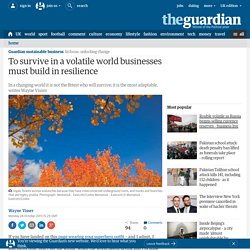
Don't get me wrong, when the world needs saving and I'm done paying off my mortgage and carrying out the trash, I'll be the first one to dial-a-superhero. But in the meantime … You see, the world has this nasty habit of changing without our permission; in fact, without us having so much as poked it in the eye. And so we – as individuals, organisations or whole nations – often find that we are no longer the agents of change, but rather its victims. Forget Disaster Recovery—Think Business Resilience and Risk Management. Companies would pay even less attention to disaster recovery than they do now if auditors and other compliance police didn't get on their cases or threaten them with fines or liability of various sorts.
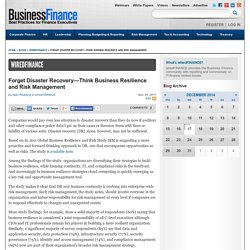
Disaster recovery (DR) alone, however, may not be sufficient. Based on its 2011 Global Business Resilience and Risk Study IBM is suggesting a more proactive and forward thinking approach to DR, one that encompasses opportunities as well as risks. The study is available here. Among the findings of the study: organizations are diversifying their strategies to build business resilience, while keeping continuity, IT, and compliance risks in the forefront. And increasingly in business resilience strategies cloud computing is quickly emerging as a key risk and opportunity management tool. The study makes it clear that DR and business continuity is evolving into enterprise-wide risk management. The addition of opportunities to the risk management calculus adds a new dimension. Continuous Application Availability: Strategy for Business Resiliency - Disaster Recovery Journal - Dedicated to Business Continuity. The Internet has transformed the landscape of business.

Traditional high availability is no longer good enough; key applications must be accessible at all times for businesses to survive and thrive in today's highly competitive and dynamic environment. Meeting these higher availability demands requires a well thought out strategy that accounts for the increasing complexity of enterprise application infrastructures. Data centers and systems now span the globe, integrating disparate business processes. Delivering application availability across these interdependencies is increasingly difficult. This complexity of applications makes it difficult to assess a priori vulnerabilities of application failures. The goal of the traditional High Availability (HA) architecture is to mitigate or prevent application downtime or outages due to failures caused by application errors or any infrastructure failure. Application Resiliency is Critical to Business Success Application-Awareness. Strategy - Building Resilience: A Workplace Strategy.
How can your organization foster resilience?
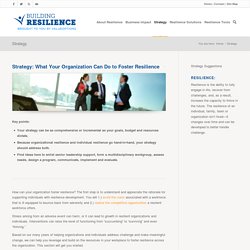
The first step is to understand and appreciate the rationale for supporting individuals with resilience development. You will 1.) avoid the costs associated with a workforce that is ill equipped to bounce back from adversity and 2.) realize the competitive opportunities a resilient workforce offers. Stress arising from an adverse event can harm, or it can lead to growth in resilient organizations and individuals. What is This Thing Called Resilience? Not long ago, I was at the White House visiting a friend who works on climate change issues.
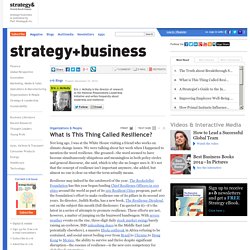
We were talking about her work when I happened to mention the word resilience. She groaned—the word seemed to have become simultaneously ubiquitous and meaningless in both policy circles and general discourse, she said, which is why she no longer uses it. It’s not that the concept of resilience isn’t important anymore, she added, but almost no one is clear on what the term actually means. Hampton Roads: Climate Adaptation, Preparedness and Resilience Exercise « The Center for Climate & Security. Hampton Roads from space, by NASA/JPL By, Sarah Volkman, Policy and Research Associate, Center for Climate and Security Early this month, legislators convened in the Hampton Roads area of Virginia to discuss the impacts of sea level rise on the region at two major events.

The threat to military installations in Hampton Roads has been one of the important discussions of the meetings. “The thing that frightens me the most is the effect of climate on our military presence,” Senator Tim Kaine said at a December 5th conference hosted by William & Mary Law School’s Virginia Coastal Policy Clinic and the Center for Coastal Resources Management at the Virginia Institute of Marine Science. In the Hampton Roads area, sea level has risen 14 inches since 1930 and the 1.6 million people in the region are the 2nd most vulnerable population center threatened by sea level rise in the U.S.. Like this: Nicolas Perony: Puppies! Now that I’ve got your attention, complexity theory. Eric Berlow: Simplifying complexity.
Business Resilience Program Model Overview. Resilience: Strategy, Risk Management, and Agility: PwC Advisory. 7 principles of resilience. Zürich Meets New York: Towards More Resilient Systems and Societies (with image, tweet) · yangbodu · Storify. Www.youthdeved.ie/sites/youthdeved.ie/files/NYCI_Bouncing_Back.pdf. Relevance of 'Resilience'? Resilience Handbook 2.0. Theory of Resilient, Systems Thinking.
Resilience in protracted crises. Resisting the mantra of resilience. Resilience has many meanings LONDON, 15 October 2012 (IRIN) - Ten years ago, resilience was little spoken of within the aid community; now the word is everywhere.
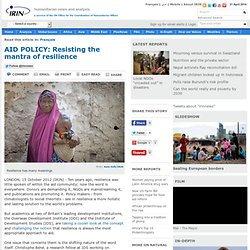
Donors are demanding it, NGOs are mainstreaming it, and publications are promoting it. Policy makers - from climatologists to social theorists - see in resilience a more holistic and lasting solution to the world’s problems. But academics at two of Britain’s leading development institutions, the Overseas Development Institute (ODI) and the Institute of Development Studies (IDS), are taking a cooler look at the concept and challenging the notion that resilience is always the most appropriate approach to aid.
One issue that concerns them is the shifting nature of the word itself. IRIN: Building resilience. Resilience-renaissance. Resilience and inequality of risk. Published: 20 May 2013 Author:
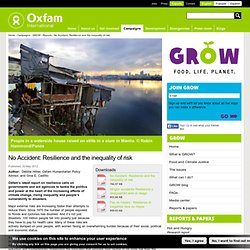
Resilience in society: infrastructure, communities and businesses - Detailed guidance. Overview Integrated emergency management (IEM) includes anticipation, assessment, prevention, preparation, response and recovery. Resilience is about all these aspects of emergency management, and this guide deals with the resilience of existing entities the UK such as buildings, systems and networks. The government’s aim is to reduce the risk from emergencies so that people can go about their business freely and with confidence. Civil protection practitioners support the work which goes on across the UK to improve emergency preparedness.
The wider UK society - public and private sector, communities and businesses - will find it useful to know how their work fits into a wider framework on resilience for their sector. Infrastructure resilience. Business Resilience and Strategic Agility: Research, Analysis, Publications: PwC. How to make your supply chain more resilient: A conversation with PwC’s Joseph Roussel Author: Joseph Roussel Between natural disasters, the financial crisis, and macroeconomic vulnerabilities, companies’ supply chains have been rocked by several disruptions of late. And that trend is likely to continue, says PwC’s Joseph Roussel, co-author of Strategic Supply Chain Management—Second Edition. In this short, informative interview, Roussel discusses why supply chains have become increasingly vulnerable, and offers specific tips on how companies can design and manage this critical strategic asset for resilience.
Resilience is both a technical and a business responsibility. Resilience (the capacity to recover quickly from difficulties; toughness) is a concept that is being discussed because – as was highlighted in the recent (ISC)2 Secure Liverpool conference – the technical environment organisations are embedded today in is fragile, prone to error, failure and insecure.